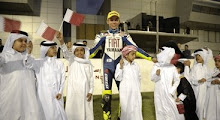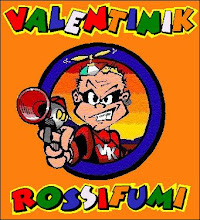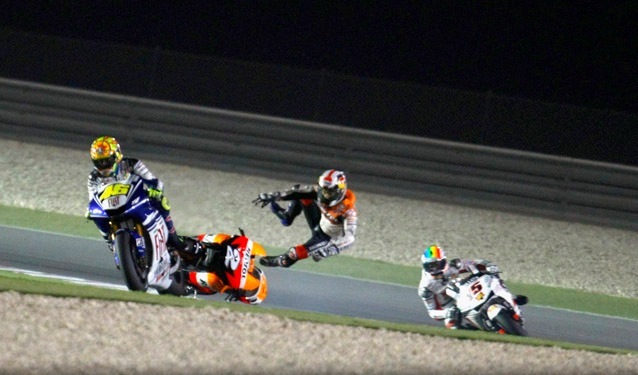 In 1994, Aprilia by way of Sandroni, used Rossi to improve its RS125R and in turn allowed Rossi to learn how to handle the fast new pace of 125 cc racing. At first he found himself on a Sandroni in the 1994 Italian championship and continued to ride it through the 1995 European and Italian championships.
In 1994, Aprilia by way of Sandroni, used Rossi to improve its RS125R and in turn allowed Rossi to learn how to handle the fast new pace of 125 cc racing. At first he found himself on a Sandroni in the 1994 Italian championship and continued to ride it through the 1995 European and Italian championships.Rossi had variable success in the 1996 World Championship season, failing to finish five of the season's races and crashing several times. Despite this, in August, he won his first World Championship Grand Prix at Brno in the Czech Republic on an AGV Aprilia RS125R. He finished the season in ninth position. Rossi treated it as a learning process and refined his skills enough to completely dominate the 125cc World Championship in the following 1997 season, winning 11 of the 15 races.
By 1998, the Aprilia RS250 was reaching its pinnacle and had a formidable team of riders in Valentino Rossi, Loris Capirossi and Tetsuya Harada. But even with a fast bike and experienced championship-winning teammates, Rossi struggled in his first season in 250cc. Rossi considered 1998 the toughest year of his career, due to the persistent pressure to perform that he felt from Aprilia, the media and effectively everyone around him. The death of two of his friends in a car accident also took a toll. Again, he found himself learning the ways of his new bike in the first season, concluding the 1998 250cc season in second place, only three points behind the champion Capirossi. In 1999, however, he won the title, collecting 5 pole positions and 9 wins.
Rossi was rewarded in 2000 for his 250cc World Championship by being given a ride with Honda in what was then the ultimate class in World Championship motorcycle racing, 500cc. Jeremy Burgess, had shown him the NSR500 and was convinced that the pairing of it with Rossi would bring nothing but success. Retired 500cc World Champion Mick Doohan, who also had Jeremy Burgess as chief engineer, worked with Rossi as his personal mentor in the first year at Honda. It would also be the first time Rossi would be racing against fierce rival, Max Biaggi. Although the two had never raced against each other, an intense rivalry had developed. It would take nine races before Rossi would win on the Honda, but like his previous seasons in 125 and 250, it was a warm-up to a dominant second season. Rossi finished 2nd to American Kenny Roberts, Jr., with Max Biaggi finishing in 3rd place.
Rossi won his first 500cc World Championship in 2001, winning 11 races. It would be the final 500cc season for Rossi and most of the premier class. Also in 2001, Rossi teamed with American rider Colin Edwards for the Suzuka 8 Hours endurance race aboard a Honda VTR1000SPW. The pair won the race despite Rossi's lack of experience racing Superbikes.
2001 was the final year of the 500 cc World Championship; the 500 cc giving way to the newly created MotoGP class. 2002 was the inaugural year for the MotoGP bikes and with all riders experiencing the same teething problems getting used to the new bikes (or dealing with the inferior 500 cc bikes), Rossi won the first race went on to win 8 of the first 9 races of the season, eventually claiming 11 victories in total.
It was more of the same in 2003 for Rossi's rivals; Rossi claimed 9 pole positions as well as 9 GP wins to his third consecutive World Championship. The Australian GP at Phillip Island in 2003 is considered to be one of Rossi's greatest career moments due to the unique circumstances in which he claimed victory. After being given a 10-second penalty for overtaking during a yellow flag due to a crash by Ducati rider Troy Bayliss, 1st-place Rossi proceeded to pull away from the rest of the field, eventually finishing more than 15 seconds ahead; more than enough to cancel out the penalty and win the race.









No comments:
Post a Comment